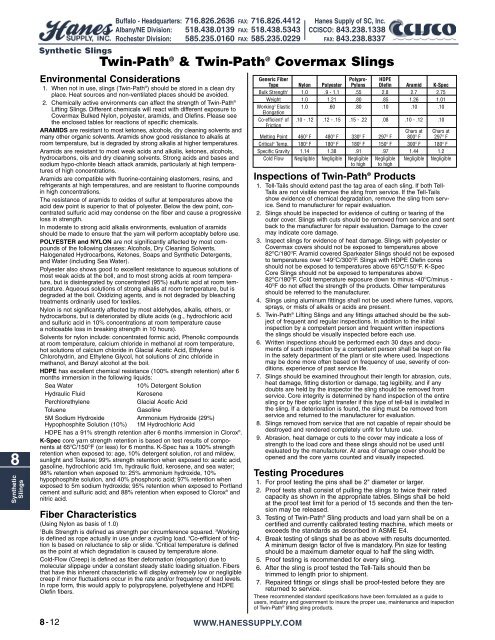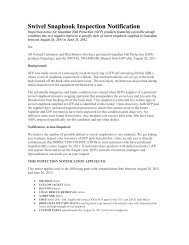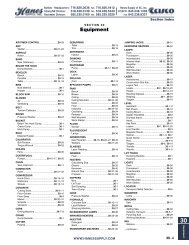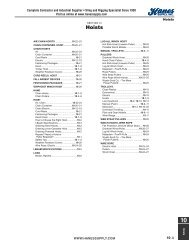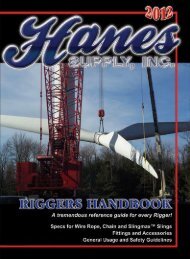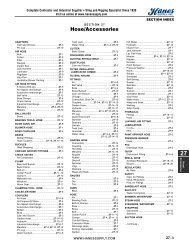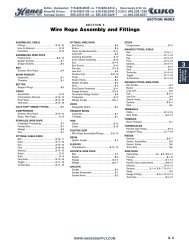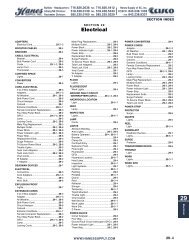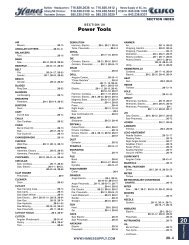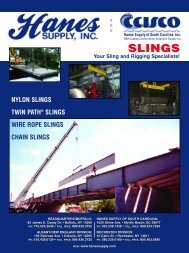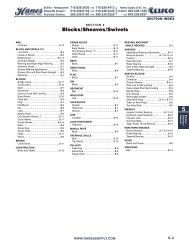Synthetic Slings - Hanes Supply, Inc
Synthetic Slings - Hanes Supply, Inc
Synthetic Slings - Hanes Supply, Inc
You also want an ePaper? Increase the reach of your titles
YUMPU automatically turns print PDFs into web optimized ePapers that Google loves.
8<br />
<strong>Synthetic</strong><br />
<strong>Slings</strong><br />
Buffalo - Headquarters: 716.826.2636 FAX: 716.826.4412<br />
Albany/NE Division: 518.438.0139 FAX: 518.438.5343<br />
Rochester Division: 585.235.0160 FAX: 585.235.0229<br />
<strong>Synthetic</strong> <strong>Slings</strong><br />
Environmental Considerations<br />
1. When not in use, slings (Twin-Path ® ) should be stored in a clean dry<br />
place. Heat sources and non-ventilated places should be avoided.<br />
2. Chemically active environments can affect the strength of Twin-Path ®<br />
Lifting <strong>Slings</strong>. Different chemicals will react with different exposure to<br />
Covermax Bulked Nylon, polyester, aramids, and Olefins. Please see<br />
the enclosed tables for reactions of specific chemicals.<br />
ARAMIDS are resistant to most ketones, alcohols, dry cleaning solvents and<br />
many other organic solvents. Aramids show good resistance to alkalis at<br />
room temperature, but is degraded by strong alkalis at higher temperatures.<br />
Aramids are resistant to most weak acids and alkalis, ketones, alcohols,<br />
hydrocarbons, oils and dry cleaning solvents. Strong acids and bases and<br />
sodium hypo-chlorite bleach attack aramids, particularly at high temperatures<br />
of high concentrations.<br />
Aramids are compatible with fluorine-containing elastomers, resins, and<br />
refrigerants at high temperatures, and are resistant to fluorine compounds<br />
in high concentrations.<br />
The resistance of aramids to oxides of sulfur at temperatures above the<br />
acid dew point is superior to that of polyester. Below the dew point, concentrated<br />
sulfuric acid may condense on the fiber and cause a progressive<br />
loss in strength.<br />
In moderate to strong acid alkalis environments, evaluation of aramids<br />
should be made to ensure that the yarn will perform acceptably before use.<br />
POLYESTER and NYLON are not significantly affected by most compounds<br />
of the following classes: Alcohols, Dry Cleaning Solvents,<br />
Halogenated Hydrocarbons, Ketones, Soaps and <strong>Synthetic</strong> Detergents,<br />
and Water (including Sea Water).<br />
Polyester also shows good to excellent resistance to aqueous solutions of<br />
most weak acids at the boll, and to most strong acids at room temperature,<br />
but is disintegrated by concentrated (95%) sulfuric acid at room temperature.<br />
Aqueous solutions of strong alkalis at room temperature, but is<br />
degraded at the boil. Oxidizing agents, and is not degraded by bleaching<br />
treatments ordinarily used for textiles.<br />
Nylon is not significantly affected by most aldehydes, alkalis, ethers, or<br />
hydrocarbons, but is deteriorated by dilute acids (e.g., hydrochloric acid<br />
and sulfuric acid in 10% concentrations at room temperature cause<br />
a noticeable loss in breaking strength in 10 hours).<br />
Solvents for nylon include: concentrated formic acid, Phenolic compounds<br />
at room temperature, calcium chloride in methanol at room temperature,<br />
hot solutions of calcium chloride in Glacial Acetic Acid, Ethylene<br />
Chlorohydrin, and Ethylene Glycol, hot solutions of zinc chloride in<br />
methanol, and Benzyl alcohol at the boil.<br />
HDPE has excellent chemical resistance (100% strength retention) after 6<br />
months immersion in the following liquids:<br />
Sea Water<br />
10% Detergent Solution<br />
Hydraulic Fluid<br />
Kerosene<br />
Perchlorethylene<br />
Glacial Acetic Acid<br />
Toluene<br />
Gasoline<br />
5M Sodium Hydroxide Ammonium Hydroxide (29%)<br />
Hypophosphite Solution (10%) 1M Hydrochloric Acid<br />
HDPE has a 91% strength retention after 6 months immersion in Clorox ® .<br />
K-Spec core yarn strength retention is based on test results of components<br />
at 65 0 C/150 O F (or less) for 6 months. K-Spec has a 100% strength<br />
retention when exposed to: age, 10% detergent solution, rot and mildew,<br />
sunlight and Toluene; 99% strength retention when exposed to: acetic acid,<br />
gasoline, hydrochloric acid 1m, hydraulic fluid, kerosene, and sea water;<br />
98% retention when exposed to: 25% ammonium hydroxide, 10%<br />
hypophosphite solution, and 40% phosphoric acid; 97% retention when<br />
exposed to 5m sodium hydroxide; 95% retention when exposed to Portland<br />
cement and sulfuric acid; and 88% retention when exposed to Clorox ® and<br />
nitric acid.<br />
Fiber Characteristics<br />
(Using Nylon as basis of 1.0)<br />
8-12<br />
WWW.HANESSUPPLY.COM<br />
<strong>Hanes</strong> <strong>Supply</strong> of SC, <strong>Inc</strong>.<br />
CCISCO: 843.238.1338<br />
FAX: 843.238.8337<br />
Twin-Path ® & Twin-Path ® Covermax <strong>Slings</strong><br />
1<br />
Bulk Strength is defined as strength per circumference squared. 2 Working<br />
is defined as rope actually in use under a cycling load. 3 Co-efficient of friction<br />
Is based on reluctance to slip or slide. 4 Critical temperature is defined<br />
as the point at which degradation is caused by temperature alone.<br />
Cold-Flow (Creep) is defined as fiber deformation (elongation) due to<br />
molecular slippage under a constant steady static loading situation. Fibers<br />
that have this inherent characteristic will display extremely low or negligible<br />
creep if minor fluctuations occur in the rate and/or frequency of load levels.<br />
In rope form, this would apply to polypropylene, polyethylene and HDPE<br />
Olefin fibers.<br />
Generic Fiber Polypro- HDPE<br />
Type Nylon Polyester Pylons Olefin Aramid K-Spec<br />
Bulk Strength 1 1.0 .9 - 1.1 .55 2.8 2.7 2.75<br />
Weight 1.0 1.21 .80 .85 1.26 1.01<br />
Working 2 Elastic 1.0 .60 .80 .10 .10 .10<br />
Elongation<br />
Co-efficient 3 of .10 - .12 .12 - .15 .15 - .22 .08 .10 - .12 .10<br />
Friction<br />
Chars at Chars at<br />
Melting Point 460 O F 480 O F 330 O F 297 O F 800 O F 297 O F<br />
CriticaI 4 Temp. 180 O F 180 O F 180 O F 150 O F 300 O F 180 O F<br />
Specific Gravity 1.14 1.38 .91 .97 1.44 1.2<br />
Cold Flow Negligible Negligible Negligible Negligible Negligible Negligible<br />
to high to high<br />
Inspections of Twin-Path ® Products<br />
1. Tell-Tails should extend past the tag area of each sling. If both Tell-<br />
Tails are not visible remove the sling from service. If the Tell-Tails<br />
show evidence of chemical degradation, remove the sling from service.<br />
Send to manufacturer for repair evaluation.<br />
2. <strong>Slings</strong> should be inspected for evidence of cutting or tearing of the<br />
outer cover. <strong>Slings</strong> with cuts should be removed from service and sent<br />
back to the manufacturer for repair evaluation. Damage to the cover<br />
may indicate core damage.<br />
3. Inspect slings for evidence of heat damage. <strong>Slings</strong> with polyester or<br />
Covermax covers should not be exposed to temperatures above<br />
82 O C/180 O F. Aramid covered Sparkeater <strong>Slings</strong> should not be exposed<br />
to temperatures over 149 O C/300 O F. <strong>Slings</strong> with HDPE Olefin cores<br />
should not be exposed to temperatures above 65 O C/150 O F. K-Spec<br />
Core <strong>Slings</strong> should not be exposed to temperatures above<br />
82 O C/180 O F. Cold temperature exposure down to minus -40 O C/minus -<br />
40 O F do not effect the strength of the products. Other temperatures<br />
should be referred to the manufacturer.<br />
4. <strong>Slings</strong> using aluminum fittings shall not be used where fumes, vapors,<br />
sprays, or mists of alkalis or acids are present.<br />
5. Twin-Path ® Lifting <strong>Slings</strong> and any fittings attached should be the subject<br />
of frequent and regular inspections. In addition to the initial<br />
inspection by a competent person and frequent written inspections<br />
the slings should be visually inspected before each use.<br />
6. Written inspections should be performed each 30 days and documents<br />
of such inspection by a competent person shall be kept on file<br />
in the safety department of the plant or site where used. Inspections<br />
may be done more often based on frequency of use, severity of conditions.<br />
experience of past service life.<br />
7. <strong>Slings</strong> should be examined throughout their length for abrasion, cuts,<br />
heat damage, fitting distortion or damage, tag legibility, and if any<br />
doubts are held by the inspector the sling should be removed from<br />
service. Core integrity is determined by hand inspection of the entire<br />
sling or by fiber optic light transfer if this type of tell-tail is installed in<br />
the sling. If a deterioration is found, the sling must be removed from<br />
service and returned to the manufacturer for evaluation.<br />
8. <strong>Slings</strong> removed from service that are not capable of repair should be<br />
destroyed and rendered completely unfit for future use.<br />
9. Abrasion, heat damage or cuts to the cover may indicate a loss of<br />
strength to the load core and these slings should not be used until<br />
evaluated by the manufacturer. At area of damage cover should be<br />
opened and the core yarns counted and visually inspected.<br />
Testing Procedures<br />
1. For proof testing the pins shall be 2" diameter or larger.<br />
2. Proof tests shall consist of pulling the slings to twice their rated<br />
capacity as shown in the appropriate tables. <strong>Slings</strong> shall be held<br />
at the proof test limit for a period of 15 seconds and then the tension<br />
may be released.<br />
3. Testing of Twin-Path ® Sling products and load yarn shall be on a<br />
certified and currently calibrated testing machine, which meets or<br />
exceeds the standards as described in ASME E4.<br />
4. Break testing of slings shall be as above with results documented.<br />
A minimum design factor of five is mandatory. Pin size for testing<br />
should be a maximum diameter equal to half the sling width.<br />
5. Proof testing is recommended for every sling.<br />
6. After the sling is proof tested the Tell-Tails should then be<br />
trimmed to length prior to shipment.<br />
7. Repaired fittings or slings shall be proof-tested before they are<br />
returned to service.<br />
These recommended standard specifications have been formulated as a guide to<br />
users, industry and government to insure the proper use, maintenance and inspection<br />
of Twin-Path ® lifting sling products.


